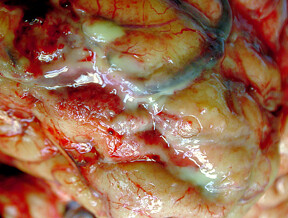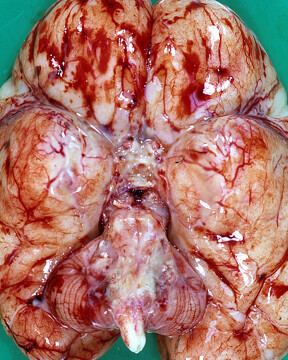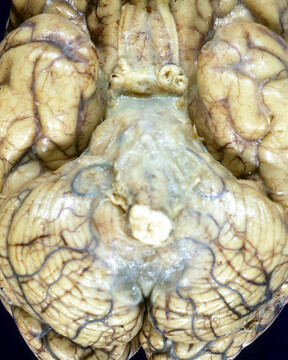Table of Contents
Definition / general | Terminology | Epidemiology | Sites | Pathophysiology | Etiology | Clinical features | Diagnosis | Laboratory | Radiology description | Prognostic factors | Case reports | Treatment | Gross images | Differential diagnosisCite this page: Cohen, M. Meningitis - bacterial. PathologyOutlines.com website. https://www.pathologyoutlines.com/topic/cnsmeningitis.html. Accessed March 31st, 2025.
Definition / general
- Acute inflammation involving the leptomeninges (particularly the arachnoid / subarachnoid space) secondary to the presence of bacteria within cerebrospinal fluid
Terminology
- Synonyms include "acute meningitis," "pyogenic meningitis" and "purulent meningitis"
Epidemiology
- As vaccines are developed and employed, the prevalence of acute bacterial meningitis has decreased and the epidemiology of inciting microorganisms has changed in proportion to successful vaccine deployment
- Currently, the most prevalent microorganisms responsible for acute bacterial meningitis are group B Streptococcus (in infants less than 2 months of age) and Streptococcus pneumoniae in all other age groups, with the exception of 11 - 17 year olds, where Neisseria meningitidis still prevails
- Haemophilus influenzae is still occasionally encountered in nonvaccinated individuals and Listeria monocytogenes comprises a few percent of cases (N Engl J Med 2011;364:2016, CMAJ 2012;184:1060, Public Health Rep 2010;125:129, Arch Dis Child 2012;97:993)
Sites
- By definition, acute inflammation resides within the subarachnoid space
- Inflammation of the dura mater ("pachymeningitis") is not included and is rather considered a separate entity as it occurs in distinctly different clinical circumstances and demonstrates distinct clinical features and disease associations
Pathophysiology
- Critical advances in the understanding and treatment of acute bacterial meningitis follow the recognition that proteins within the bacterial cell wall are responsible for inciting the acute inflammatory response, even in the absence of viable bacteria
- Although many molecules may be involved, lipopolysaccharide in the walls of gram negative organisms and techoic acid in the walls of gram positive microorganisms activate brain microglia, leading to a cascade of inflammatory changes resulting in cortical microvascular permeability with diffuse cerebral edema, resulting in increased intracranial pressure
- Recognition of this inflammatory cascade has lead to the use of less bacteriolytic antibiotics as well as concomitant high dose corticosteroid administration during the acute phases of bacterial meningitis (J Clin Invest 2007;117:2004, Arq Neuropsiquiatr 2012;70:366)
Etiology
- Organisms responsible for community acquired bacterial meningitis are discussed above
- Bacterial meningitis following penetrating head trauma (either accidental or neurosurgical) are often caused by gram negative bacteria including Escherichia coli and Klebsiella pneumoniae
Clinical features
- Classic clinical features include fever, headache, stiff neck and a variety of illicit reflexes secondary to meningeal irritation; with increased intracranial pressure, decreased cerebral perfusion may rapidly lead to loss of consciousness and death
- Delayed therapy may also result in vascular inflammation with cerebral infarction (Cleve Clin J Med 2012;79:393)
Diagnosis
- Diagnoses of acute bacterial meningitis is made through a combination of the clinical symptomatology and symptoms described above and the cerebrospinal fluid (CSF) findings described below (Clin Microbiol Rev 2010;23:467, Pediatrics 2010;126:952, Am Fam Physician 2010;82:1491)
Laboratory
- Comparison of normal cerebrospinal fluid cell count and chemistry with that generally encountered in patient with acute bacterial meningitis
Condition Normal Bacterial meningitis WBC (/ul) < 5 > 500 (mostly PMNs) Protein (mg/dl) < 45 > 100 Glucose (mg/dl) > 45 < 40 CSF/serum glucose > 0.6 < 0.4
- As cerebrospinal fluid glucose levels are dependent on circulating serum glucose levels, the CSF to serum glucose ratio is felt to be a more reliable parameter for the diagnosis of acute bacterial meningitis than absolute CSF glucose levels
- Although the detection of acute meningitis is fast and reliable, molecular testing for specific microorganisms varies in both sensitivity and specificity
- Therefore clinical vigilance must remain high during the treatment of this life threatening process (Arq Neuropsiquiatr 2013;71:693, Pediatrics 2010;126:62)
Radiology description
- Acute bacterial meningitis usually presents with striking effacement of cerebral sulci and ventricular spaces secondary to diffuse cerebral edema
- In addition, meningitic labyrinthitis on MRI predicts patients likely to develop postmeningitic hearing loss (Arch Otolaryngol Head Neck Surg 2011;137:441)
- In patients who survive untreated, subsequent basal ganglia infarcts occur secondary to infectious vasculitis
Prognostic factors
- Survival depends on prompt recognition of acute bacterial meningitis, followed by institution of appropriate antibiotic therapy
- Early administration of high dose corticosteroid therapy reduces cerebral edema and improves survival
- Approximately 15% of patients die from acute bacterial meningitis
- Those surviving may develop post meningitic complications such as hydrocephalus and hearing loss (see "Radiology" above) (Mayo Clin Proc 2009;84:403, Pediatrics 2012;130:e8)
Case reports
- 17 year old boy with postoperative meningitis and epidural abscess (Intern Med 2012;51:2645)
- 18 year old man with meningococcal septic shock (Anaesthesiol Intensive Ther 2012;44:212)
- 37 year old woman with tuberculous meningitis (BMJ Case Rep 2012;Jul 9:2012)
Treatment
- Successful treatment relies on early initiation of appropriate antibiotic therapy, accompanied by high dose corticosteroids to reduce brain swelling
- Additional neuro-intensive support measures may be utilized as necessary to normalize intracranial pressure (Respir Med 2009;103:945, Neurotherapeutics 2012;9:124, Cochrane Database Syst Rev 2013;(3):CD008806, N Engl J Med 2007;357:2507)
Gross images
Differential diagnosis
- Clinical differential diagnosis of acute bacterial meningitis is broad
- However, with typical imaging and cerebrospinal fluid cell counts and chemistries, the major differential diagnosis revolves around identification of the inciting organism
- Poor initial response to antibiotics should raise suspicion of a nonclassical bacterial etiology, as well as the possibility of acute meningitis secondary to a nonbacterial organism, such as a fungus or protozoa







